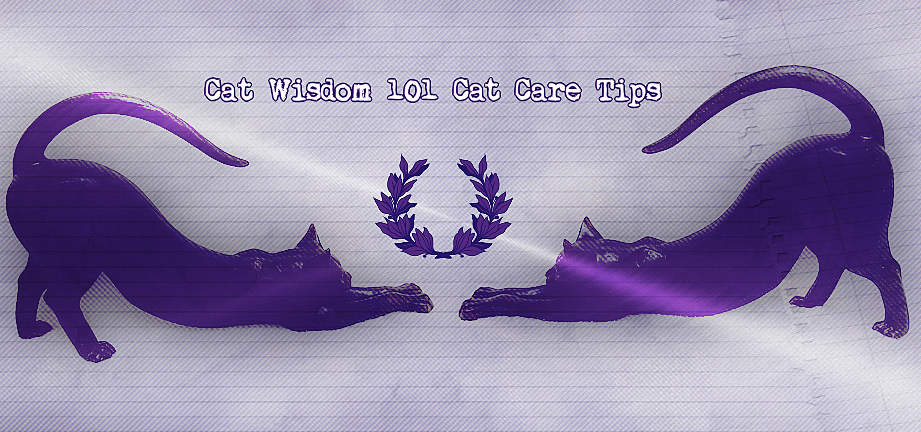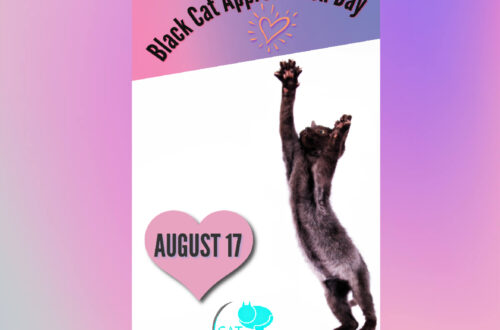
Monthly Physical Exams – Take an Active Role in Your Cat’s Health – Part Four

This is an updated post. Our primary vet, Dr. Rich Goldstein came over yesterday to check out Merlin. There’s something magical about a mobile clinic on wheels. A few steps outdoors on a muggy day with Merlin in our arms and poof, up two steps to an air-conditioned clinic. Geriatric cats like Merlin require more frequent vet visits and there’s no magic wand to turn back time. It’s awe-inspiring to observe an old-school vet and feline specialist like Dr. G. at work. I always learn something new. He showed me how to palpate Merlin’s knee so I could see for myself a swelling likely from arthritis. I’d noticed him slowing down when walking and climbing stairs but he didn’t favor one side or limp. Cats are notorious for hiding any sign of illness and it was easy over look. What I find easiest is to compare one side or part of the anatomy with another.
One thing we can’t hide from is the scale. Merlin was down a pound, largely from being dehydrated and from losing muscle mass. That means more frequent sub-q fluids. We’ve gone from once to twice a week and now every second day. Eventually (hopefully not for awhile!) it’ll be daily. What we and all cat parents can do is to learn to be more active inbetween vet visits. It’s easy to learn how to check for dehydration by tenting the skin at the scruff of the neck. With a well-hydrated cat it’s snap back within 2 seconds.
Merlin is in decline but as Dr. G. says, “He’s doing well for a 100-year-old man.”
This guest post is timely and I hope helps you understand your cat on a deeper level. As a holistic practitioner, I look at the whole picture. There is the scientific and practical info from a vet but not all vets subscribe to alternative or complementary healing. I like to use supplements and energy healing like Reiki, which Merlin will be getting more of. Anything we can do enhance out cats’ health is good but at the root is a proper diagnosis by a vet.
Monthly Physical Exams – Take an Active Role in Your Cat’s Health – Part Four is the final part of our guest post series by Georgia Barbush.
The fourth part of our Physical Exam Series covers your cat’s muscles, skeleton, abdomen, and urogenital system. While the structures that make up these tissues and organs are hidden within the body, external signs and symptoms can give us valuable insight about their overall function. If you notice any abnormalities, please contact your veterinarian right away.
Musculoskeletal
One of the most common and apparent signs of injury or illness within the musculoskeletal system is limping or lameness. Pay attention your cat’s overall movement as she walks and trots towards and away from you. A healthy gait looks even and rhythmic. Some cats may work hard to hide obvious signs of pain, but there are other ways to evaluate muscles, bones, and joints. You’ll want to look for:
- Reluctance to jump or climb, especially to areas your cat usually enjoys
- Slower movement overall
- Uncharacteristic grumpiness or irritability
- Decreased activity and playfulness
- Restlessness or difficulty settling
- Vocalization
- Decreased appetite
- Decreased grooming
- Prolonged or seemingly unexplained purring
- Note: In addition to a response to contentment, cats use purring as a self-soothing mechanism in response to pain or fear.
Also take some time to feel your pet’s muscles. Apply gentle pressure in these areas with the pads of your fingers and watch for signs of pain: wincing, lip licking, vocalization, etc. This is also a good opportunity to take note of any unusual lumps or bumps you may find. While conditions such as arthritis and muscle injuries are more commonly associated with dogs, they occur fairly frequently in cats as well, but are easier to overlook. Fortunately there are many effective treatment options available for arthritis and similar conditions. As with so many things, treatment and management is most successful when these conditions are caught in their earliest stages.
Abdomen
In addition to the stomach and intestinal tract, the abdomen contains other vital organs including the liver, kidneys, and pancreas. The first step in evaluating your cat’s abdomen is to look at it from the side and head on. It is very important to note that, while a “big belly” is often associated with obesity, it could signify many other serious conditions, from congestive heart failure that results in abdominal fluid build up to feline infectious peritonitis, or FIP. After a visual inspection, use your hands to gently feel the abdominal. Some cats are more comfortable with having this area touched, so take your cat’s preferences into account.
- In particular you’ll want to look for:
- Any indications of pain or discomfort
- Lumps, bumps, or swollen areas
- A hard, taught, or tight feeling abdomen
- A fluid-filled abdomen (think of a water balloon)
- Beyond physical palpation, you’ll also want to take note of:
- Changes in appetite
- Vomiting
- Diarrhea
- Constipation or straining in the litter box
- Small, hard, dry, stools
- Any cat experiencing diarrhea, vomiting, or constipation for more than one day should receive veterinary care.
In addition, large quantities or frequent incidents of vomiting or diarrhea within a single day also warrant veterinary treatment. This is especially critical for kittens, as they can become dangerously dehydrated and hypoglycemic very quickly.
Urogenital System
Keeping track of how often and how much your cat urinates can be difficult, especially if you have multiple cats. Unfortunately, cats are prone to a number of conditions that affect their urine output, including kidney disease and urethral obstructions. An obstructed urethra is an especially critical emergency; left untreated, a complete obstruction can be fatal within days. Try to be as observant as possible about the general volume of urine in the litter, changes in color (blood is a common cause), and odd odors. Also try to keep track of how much your cat is drinking. Both increases and decreases in fluid intake and fluid output are cause for concern. If you have more than one cat, look for changes in total quantities. If you notice a change, you can separate your cats for a day to help identify the affected cat. Another option is to set up a litter box video camera. This will also help you to discover if your cat it having frequent, unproductive trips to litter box, which could be due to a urinary tract infection or a urethral blockage, among other things.
When you do your physical exam, check for growths or masses around the nipples (most cats have eight). Mammary cancer is extremely common in intact female cats. Though much less common, mammary tumors can occur in males and spayed females as well. With intact females, check for vaginal discharge and abnormal estrous cycles. For intact males, palpate the scrotum and testes for textural abnormalities, swelling, or growths. Of course, spaying and neutering completely eliminate the risk of certain cancers while significantly reducing the risk of several others.
Conclusion: By taking the time to do a basic physical exam of your pet each month you will have a much higher likelihood of catching a medical condition in its earliest and most treatable stages. You will also be able to provide your veterinarian with a more complete and detailed picture of your pet’s health trends, improving his or her ability to accurately evaluate your pet’s health and diagnose any existing conditions. Lastly, taking an active role in your cat’s physical well being will strengthen the bond you share.
We'd love a vote. Remember ever vote counts! Vote for Cat Wisdom 101 at Pettie Awards. Georgia Barbush a registered vet tech from California. She and her husband, Mike, are also the owners of Peach Industries. Their Kitty Lounger cat hammocks and other eco-friendly pet products can be found atpeachindustries.com
[Tweet “How to examine your #cats at home, in between vet visits “]





10 Comments
Pingback:
Skeeter and Izzy
This is why I love your blog so much! Great indepth,easy to understand and follow information that may save a cat’s life!
Thank you Layla and Thank you Georgia!
Luvs Skeeter and Izzy and the Feral Gang + Twig and Peanut and Romeo
P.S. Twig, Peanut and Romeo had their nip tucks done today….yayyyyyyyyyyyyy!!!
Angel Abby
Excellent information for all cat owners
Connie Marie
Great info to know! I realized the hard way about the increased vocalizations, from the cat I was house sitting. They didn’t tell me she’d had kidney disease for years, till what ended up being the last month of her life. I tried to help, she went downhill fast and had to be put to sleep for her benefit. It was so difficult.
Carolyn
One of the problems I have is that as Austin does nearly all his private business outside, I cannot check his poop or his urine production. I just try to pay special attention to all the rest and I do watch him very carefully! Great info. x
Layla Morgan Wilde (Cat Wisdom 101)
That’s a really good point. Do you see where he goes outdoors?
da tabbies o trout towne
thanx veree much for sharin this info N heerz two a grate week oh end everee one !!
The Island Cats
This is great info. Thanks for sharing it with all of us.
Kathryn
Such helpful information. Thank you.
A ye. ar ago and 3 weeks ago, our Cheddar had urinary obstruction due to struvite crystals. He became miserable quickly and wasn’t drinking,but obviously in pain.
I spent the night with him on the couch and took him to the vet hospital, where he was given emergency treatment the and he is now a much happier camper on vet food.
Layla Morgan Wilde (Cat Wisdom 101)
I remember this so well and glad it had a happy ending!